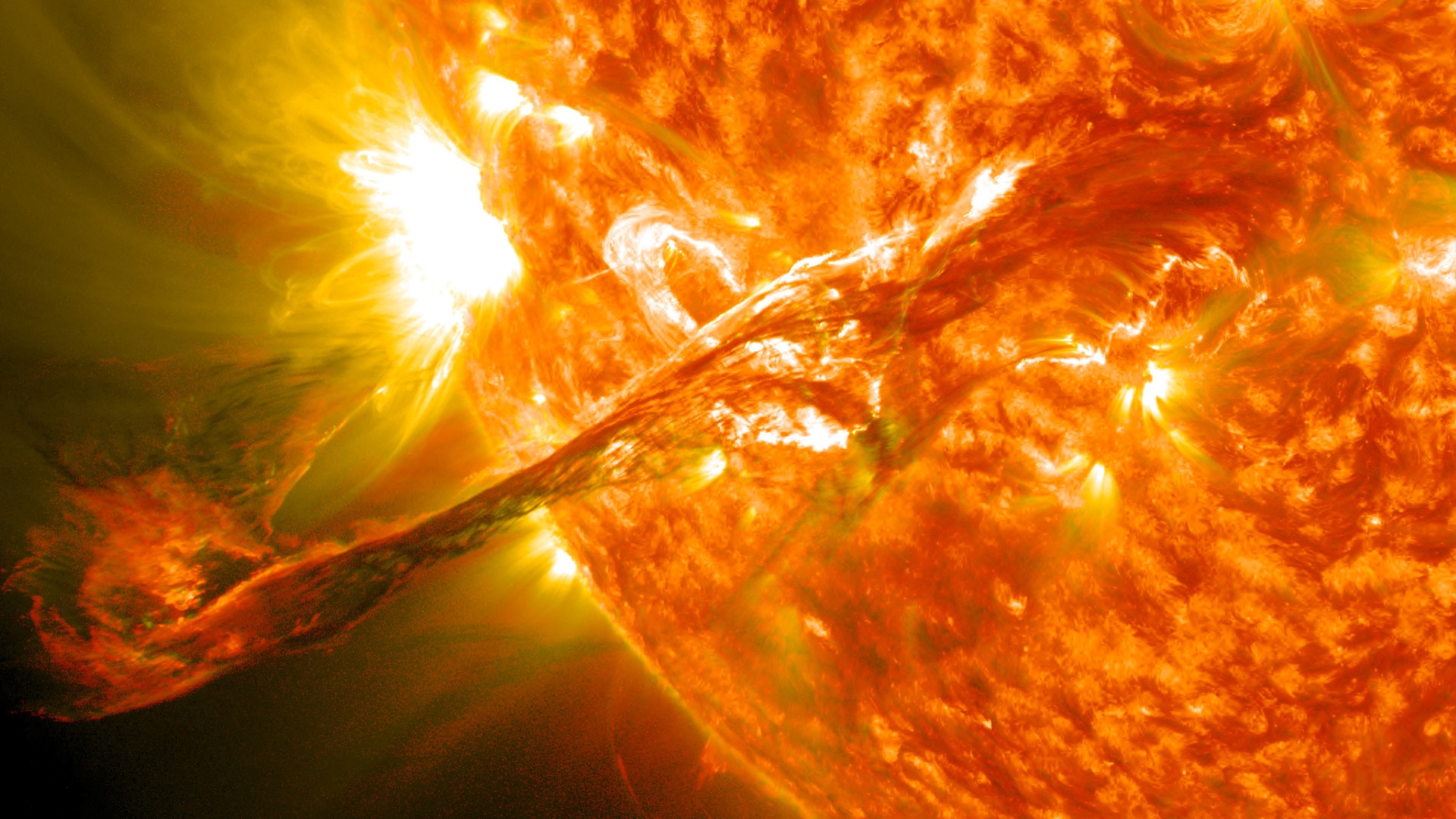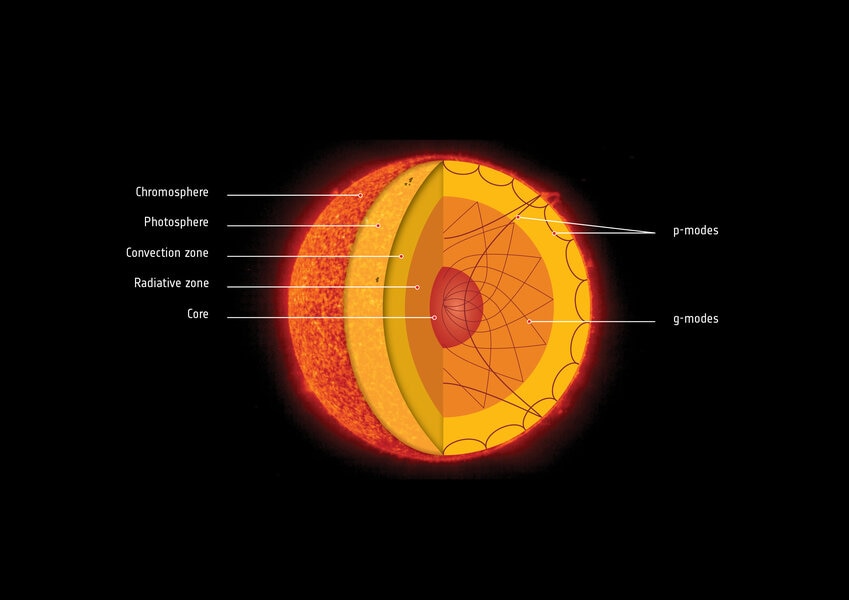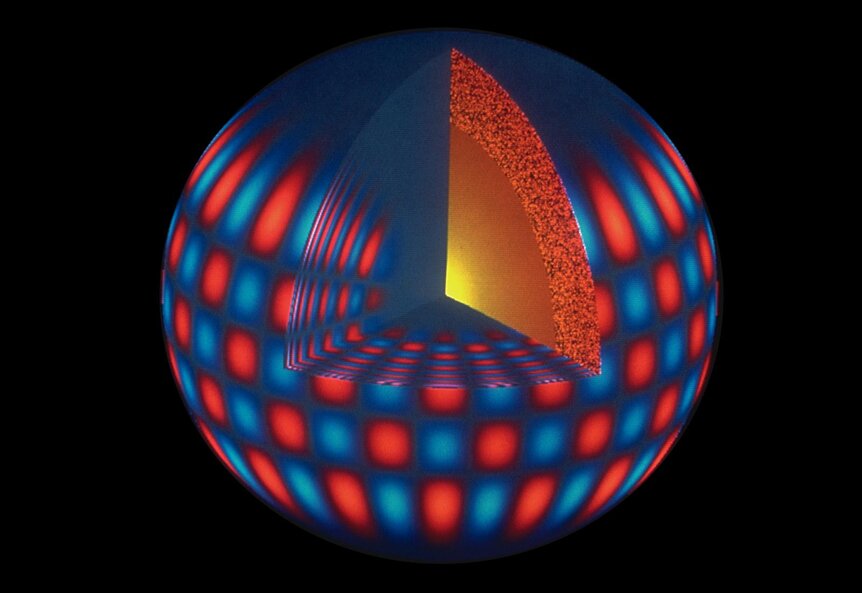Create a free profile to get unlimited access to exclusive videos, sweepstakes, and more!
Spin zone: The Sun’s core rotates four times faster than the surface

The Sun is the closest star to us in the entire Universe, so you’d think we’d know the most about it. And in many senses we do; we can view the surface in high resolution and see details there we cannot in other stars.
But there’s still a lot about it we don’t know, and lots of questions remain unanswered. Some seem simple enough. For example: How fast does the Sun’s core rotate?
Now we know: It spins around almost exactly once a week. The weird thing is, that’s four times faster than the Sun’s surface rotation! The Sun’s insides spin faster than its outsides.
So there’s a bit to break down here, but it’s pretty cool. OK, fine: It’s hot. But the news is cool.
The Sun is not a solid ball, but is instead a gigantic sphere of gas (technically, it’s a plasma, a gas in which the atoms have lost one or more electrons; that’s actually important, as we’ll see in a sec). Overall, the Sun is about 1.4 million kilometers wide. At the center, the temperature and pressure are so high (15 million degrees C and hundreds of billion times Earth’s atmospheric pressure at sea level!) that hydrogen atoms slam into each other and through a complicated process fuse into helium. This releases a lot of energy — a lot — and that’s why the Sun shines. This energy works its way out of the solar interior and radiates away from the surface as light.
The region where hydrogen is transmogrified into helium is called the core, and it’s about 1/5th of the Sun’s diameter: roughly 280,000 km wide (somewhat less than the distance from the Earth to the Moon, for comparison). We know it’s there, despite being buried under a half million kilometers of raging plasma, due to the physics of how the Sun works — the discovery of nuclear fusion was a huge breakthrough in understanding solar dynamics.
When we look at the Sun from the outside, we see it spinning. Even though the surface isn’t solid and is always changing, there are a few ways to measure the rotation rate: For example, you can watch sunspots and use them as landmarks (well, plasmamarks, I guess). When you do, you find that the Sun rotates once every few weeks or so. Moreover, it rotates at a higher rate at the equator versus the poles; 25 versus 35 days. That “differential rotation” is again because the Sun isn’t a solid body, and sloshes around a bit.
But how fast does the core rotate? That number has been long sought, and has been maddeningly elusive. However, a new method has finally revealed the answer ... and it’s because the Sun is vibrating.
Between the core and the surface is a region of the Sun called the convective zone, where hot plasma rises and cool plasma sinks, similar to water boiling in a pan. There are thousands of these cells of plasma moving up and down inside the Sun, and they agitate the material around them. This creates a pressure wave, similar to a sound wave. When these reach the Sun’s surface they cause it to vibrate, and these vibrations can be measured. The physics of waves is well enough understood that the properties of these waves can be used to measure conditions inside the Sun, so we can figure out what’s going deep beneath the surface without ever seeing it directly. The science of this is called helioseismology.
The problem here is that these pressure waves (also called p-waves) travel pretty rapidly through the dense regions deep inside the Sun, so they’re not sensitive to the core’s relatively slow rotation. They can’t be used directly to measure how quickly the core rotates.
Ah, but there’s another type of wave, called a gravity wave (or g-wave, not to be confused with gravitational waves, which are very different). This is the same kind of wave you get when you move around in your bathtub: Water gets pushed up, and gravity pulls it back down. The water picks up speed as it falls and overshoots a little, dipping down and creating a trough between crests. Those crests get pulled down, and so on, creating the g-wave.
With the Sun, these waves are generated at the core, but they don’t make it out to the surface, so they can’t be measured directly. Arg!
But wait! There’s a solution here. It turns out that when p-waves pass through the core, the material moving under the influence of g-waves interacts with them, changing the way p-waves move through it. The effect is incredibly subtle, but with careful measurement it can be seen.
And it finally has been, using the venerable Solar and Heliospheric Observatory (SOHO), a space-based observatory dedicated to observing the Sun. An instrument on board SOHO, called Global Oscillations at Low Frequencies (or GOLF), was designed to look at solar p-waves. By taking measurements over a staggering 16.5 years (SOHO launched in 1995), astronomers were able to see the subtle effect of g-waves on them. It’s these measurements that indicate the solar core rotates much faster than the surface.
This has been suspected for years, and it’s nice to see it confirmed. And I have to admit, as soon as I heard this I did a mental forehead slap. I should’ve known the core would spin faster!
Why? From physical theories, we think stars spin rapidly when they’re born. We see lots of confirmation of this by observing young stars, too. But the Sun’s surface spins only once a month or so. This is most likely due to its magnetic field: the powerful magnetism generated inside the Sun. It’s not well understood exactly where the magnetism is created, but it’s certainly above the core, in or just above the convection zone. A very well-known property of physics is that moving charged particles create a magnetic field, and the plasma moving up and down in the Sun’s convective region therefore does just that.
Above the Sun’s surface, the magnetic field acts like a gigantic net, sweeping up subatomic particles emitted from the Sun and speeding them up, like a fishing net picking up fish. As it does, the particles push back a little bit on the magnetic field. Since the magnetism is anchored in the Sun’s material, this acts, over billions of years, to slow the Sun’s rotation down.
But the magnetic field isn’t anchored in the core. The outer layers slow down, but the core is still free to spin faster. Sure, friction will slow it down, but even after 4.5 billion years it will still be rotating faster than the Sun’s surface — a ball of plasma nearly 300,000 km across has a substantial amount of momentum. I don’t study the Sun specifically, but I knew all this, and I should’ve been able to piece it together myself. It never occurred to me, but it seems obvious now. Ah, well.
So, anyway, this is pretty nifty. We don’t have a lot of ways to study the Sun’s core, and now we have a new one that looks very promising. Rotation is just one of many properties of the core we can learn about using this method. It’s like a window that allows us to see past the septillions of tons of plasma in the Sun and get information on the depths below.
We’ve been studying the Sun for centuries, but there’s still so much to learn about it! It’s very welcome to have a new tool to use to study it.




























